Dassault Aviation Bundle
Who Really Owns Dassault Aviation?
Ever wondered who steers the course of a global aerospace giant? Understanding the Dassault Aviation SWOT Analysis reveals critical insights, but it all begins with ownership. A company's ownership structure dictates its strategic direction, influencing everything from innovation to market expansion.
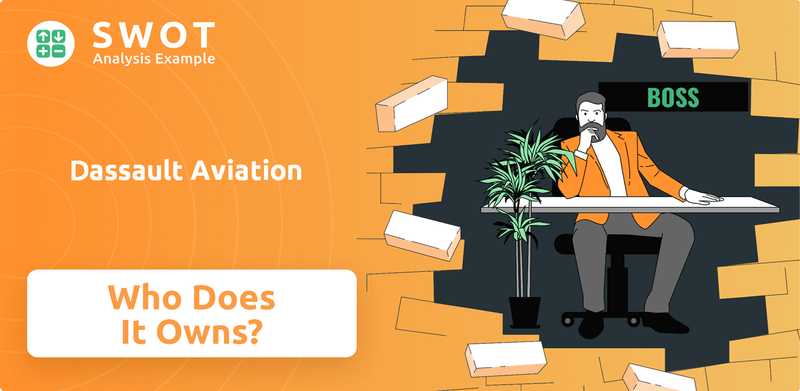
Unraveling the Dassault ownership reveals a fascinating narrative of family legacy, strategic investments, and public influence. From its inception by Marcel Dassault to its current status, the Dassault company has navigated a complex landscape. This exploration will detail the evolution of Dassault Aviation's ownership, examining key stakeholders and their impact on the company's trajectory, providing a comprehensive understanding of who owns Dassault.
Who Founded Dassault Aviation?
The genesis of the modern aerospace giant, now known as Dassault Aviation, traces back to Marcel Dassault (born Marcel Bloch), a pioneering French aircraft designer and entrepreneur. He established the company in 1929 under the original name Société des Avions Marcel Bloch. From its inception, Marcel Dassault's influence was paramount, shaping its design philosophy and manufacturing processes.
Marcel Dassault maintained a significant stake in the company from its inception, reflecting his deep involvement in its design and manufacturing processes. While specific equity splits or shareholding percentages at the company's exact inception are not widely detailed in public records, it is understood that Marcel Dassault was the primary owner and driving force behind the enterprise. Early operations were likely self-funded or supported by limited private capital, typical of nascent aerospace ventures of that era.
The early ownership structure of Dassault Aviation was primarily centered around Marcel Dassault. The company's growth was largely propelled by Marcel Dassault's engineering prowess and his ability to secure early contracts for military aircraft. There is no widely documented initial ownership disputes or buyouts in the company's earliest history. Marcel Dassault's singular vision for advanced aircraft design and production was deeply embedded in the company's foundational structure, with control firmly centralized around him.
Founded in 1929 by Marcel Dassault, initially named Société des Avions Marcel Bloch. This marked the beginning of what would become a major player in the aerospace industry.
Marcel Dassault was the primary owner, reflecting his deep involvement in design and manufacturing. Early operations were likely self-funded or supported by limited private capital.
Marcel Dassault's vision for advanced aircraft design was central to the company's early success. His leadership established a clear strategic direction from the start.
The company's early growth was fueled by Marcel Dassault's engineering skills and early contracts. Public records do not detail specific angel investors or early financial backers.
The company's initial success was driven by Marcel Dassault's ability to secure early contracts for military aircraft. This helped establish its reputation and financial stability.
Control was firmly centralized around Marcel Dassault, allowing for rapid decision-making and a clear strategic direction. This founder-led approach was crucial in the company’s formative years.
The initial ownership structure of Dassault Aviation, with Marcel Dassault at the helm, laid the groundwork for its future expansion. The company's focus on innovation and its ability to secure contracts were critical in its early years. For a deeper dive into the market dynamics, consider exploring the Target Market of Dassault Aviation.
The early ownership of Dassault Aviation was primarily controlled by its founder, Marcel Dassault.
- Marcel Dassault's vision and leadership were central to the company's early success.
- The company's early growth was fueled by Marcel Dassault's engineering expertise and early contracts.
- There is no readily available public information detailing specific angel investors or friends and family who acquired stakes.
- The strong founder-led approach allowed for rapid decision-making and a clear strategic direction.
Dassault Aviation SWOT Analysis
- Complete SWOT Breakdown
- Fully Customizable
- Editable in Excel & Word
- Professional Formatting
- Investor-Ready Format
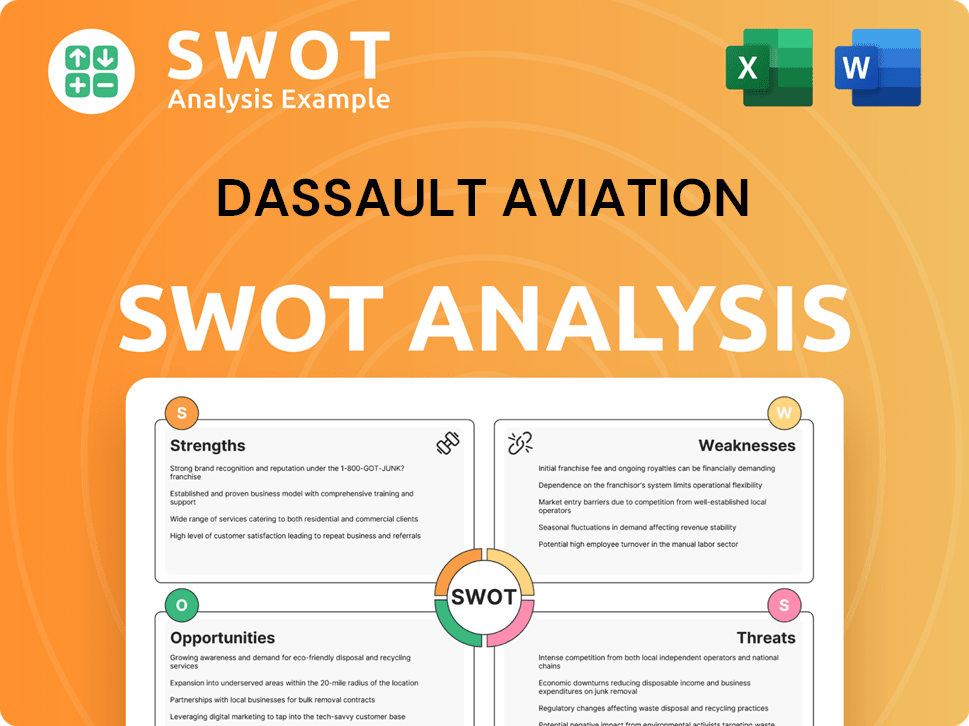
How Has Dassault Aviation’s Ownership Changed Over Time?
The evolution of Dassault Aviation's ownership reflects a transition from private to public control, significantly shaped by the Dassault family's influence. Key events include the initial public offering (IPO), which allowed public investment, although the exact date of full public listing and initial market capitalization is complex due to the company's structure and the Dassault Group's broader holdings. This shift marked a crucial moment in the company's history, opening it up to a wider investor base while maintaining a core of family control.
The ownership structure has been consistently influenced by the dominant stake held by the Dassault family. This concentrated ownership allows for long-term strategic planning, often prioritizing research and development and maintaining a strong focus on core aerospace competencies over short-term market pressures. The family's continued investment in programs like the Rafale and the development of new Falcon jets underscores this long-term vision.
| Ownership Aspect | Details | As of |
|---|---|---|
| Major Stakeholder | Groupe Industriel Marcel Dassault (GIMD) | Late 2024 - Early 2025 |
| GIMD Shareholding | 62.17% of share capital, 77.24% of voting rights | December 31, 2023 |
| Airbus SE Shareholding | 9.92% of share capital, 7.82% of voting rights | December 31, 2023 |
| Public Float | Includes institutional investors, mutual funds, and individual shareholders | Ongoing |
The primary major stakeholder in Dassault Aviation is the Dassault family, primarily through Groupe Industriel Marcel Dassault (GIMD). GIMD holds a significant majority stake, ensuring the family's continued strategic control over the company. As of December 31, 2023, GIMD held 62.17% of Dassault Aviation's share capital and 77.24% of its voting rights. Another notable major shareholder is Airbus SE, holding 9.92% of the share capital and 7.82% of the voting rights as of the same date. The remaining shares are publicly traded, representing a free float.
The Dassault family, through GIMD, maintains significant control over Dassault Aviation.
- Airbus SE is a notable minority shareholder.
- The public float represents a portion of the company's shares available for trading.
- The ownership structure influences long-term strategic decisions.
- The Dassault family's continued involvement ensures a focus on aerospace innovation.
Dassault Aviation PESTLE Analysis
- Covers All 6 PESTLE Categories
- No Research Needed – Save Hours of Work
- Built by Experts, Trusted by Consultants
- Instant Download, Ready to Use
- 100% Editable, Fully Customizable
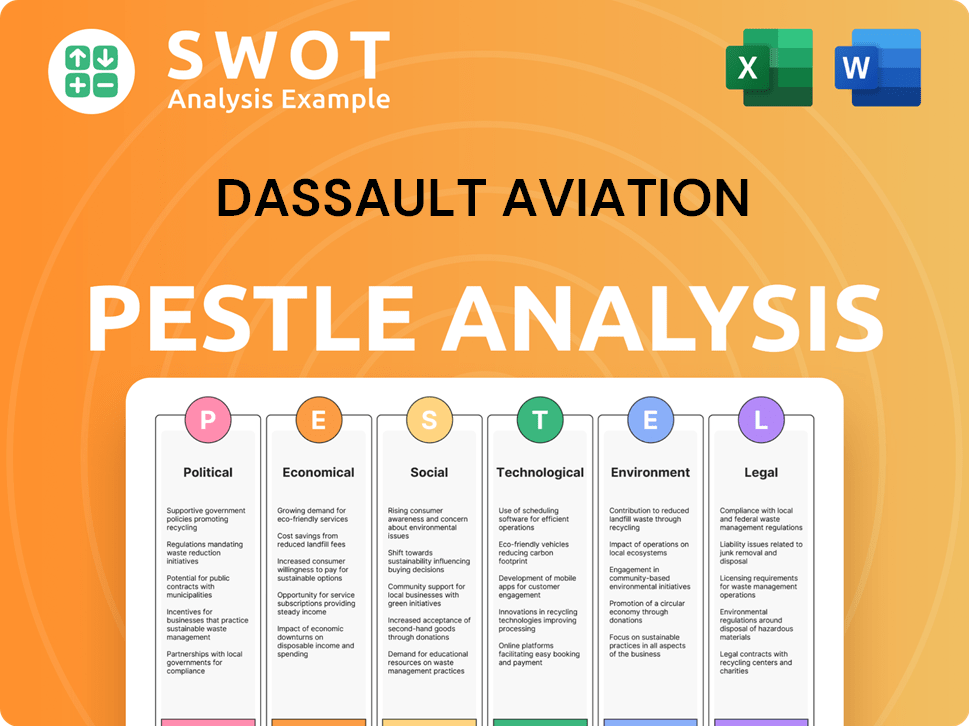
Who Sits on Dassault Aviation’s Board?
The current Board of Directors of Dassault Aviation includes a mix of representatives from major shareholders and independent members. This structure aims to balance oversight with strategic alignment, particularly with the controlling interests of the Dassault family. Éric Trappier, linked to the Dassault Group, serves as Chairman and CEO. The board also includes independent directors and representatives from key stakeholders, bringing expertise in aerospace, finance, and international business.
The board's composition reflects the company's need for both operational expertise and strategic guidance, ensuring that decisions align with the long-term vision of the Dassault family. This blend of perspectives is crucial for navigating the complexities of the aerospace industry and maintaining the company's competitive edge. The board's structure supports the company's strategic goals and its ability to adapt to market changes.
| Board Member | Role | Affiliation |
|---|---|---|
| Éric Trappier | Chairman and CEO | Groupe Industriel Marcel Dassault (GIMD) |
| Various | Independent Directors | Independent |
| Various | Representatives | Key Stakeholders |
Dassault Aviation's voting structure features a dual-class share system, granting the Dassault family disproportionate voting power. As of December 31, 2023, Groupe Industriel Marcel Dassault (GIMD) held 62.17% of the share capital but controlled 77.24% of the voting rights. This structure, common in family-controlled European companies, ensures the Dassault family maintains effective control over strategic decisions. This control is achieved through specific voting rights attached to certain share classes, often referred to as 'golden shares'.
The Dassault family's control is maintained through a dual-class share system, ensuring strategic decisions align with their long-term vision. This structure provides stability in a capital-intensive industry, minimizing the impact of short-term market fluctuations.
- Groupe Industriel Marcel Dassault (GIMD) holds the majority of voting rights.
- The dual-class share system grants the Dassault family disproportionate voting power.
- This structure supports long-term strategic planning in the aerospace industry.
- The stability provided by concentrated voting power is crucial for product development.
Dassault Aviation Business Model Canvas
- Complete 9-Block Business Model Canvas
- Effortlessly Communicate Your Business Strategy
- Investor-Ready BMC Format
- 100% Editable and Customizable
- Clear and Structured Layout
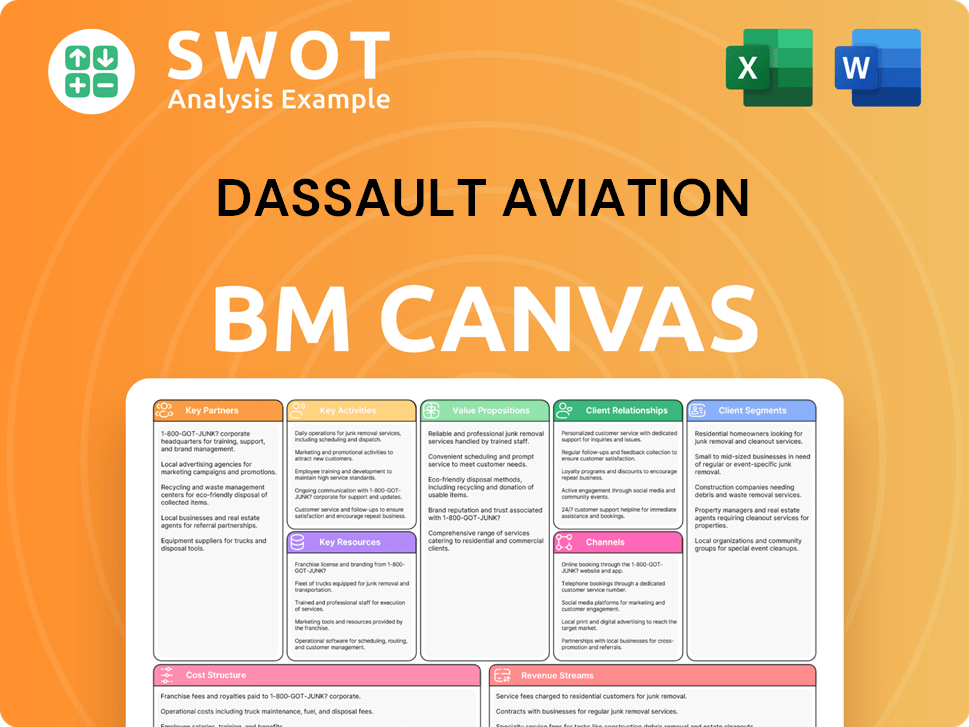
What Recent Changes Have Shaped Dassault Aviation’s Ownership Landscape?
Over the past few years, the ownership structure of Dassault Aviation has remained relatively stable. The Dassault family, through Groupe Industriel Marcel Dassault (GIMD), continues to hold a significant majority stake. This stability contrasts with some industry trends, such as increased institutional ownership or founder dilution. As of December 31, 2023, GIMD held 62.17% of the share capital and 77.24% of the voting rights, demonstrating their enduring control.
While the core ownership structure has been consistent, the company's ordinary business activities, such as share buybacks, could indirectly influence the public float. However, no major changes in control through mergers or acquisitions have impacted Dassault Aviation. The leadership, with Éric Trappier as Chairman and CEO, has maintained continuity in strategic direction. The company's financial performance, including ongoing orders for the Rafale fighter jet and sustained demand for Falcon business jets, contributes to its stability. For further insights into the competitive environment, consider exploring the Competitors Landscape of Dassault Aviation.
The Dassault family's control through GIMD has remained strong. This stability is a key characteristic of Dassault Aviation's ownership. The company's focus remains on long-term strategic development.
GIMD held 62.17% of share capital and 77.24% of voting rights as of December 31, 2023. This highlights the significant influence of the Dassault family. The consistent leadership under Éric Trappier also plays a crucial role.
Dassault Aviation Porter's Five Forces Analysis
- Covers All 5 Competitive Forces in Detail
- Structured for Consultants, Students, and Founders
- 100% Editable in Microsoft Word & Excel
- Instant Digital Download – Use Immediately
- Compatible with Mac & PC – Fully Unlocked
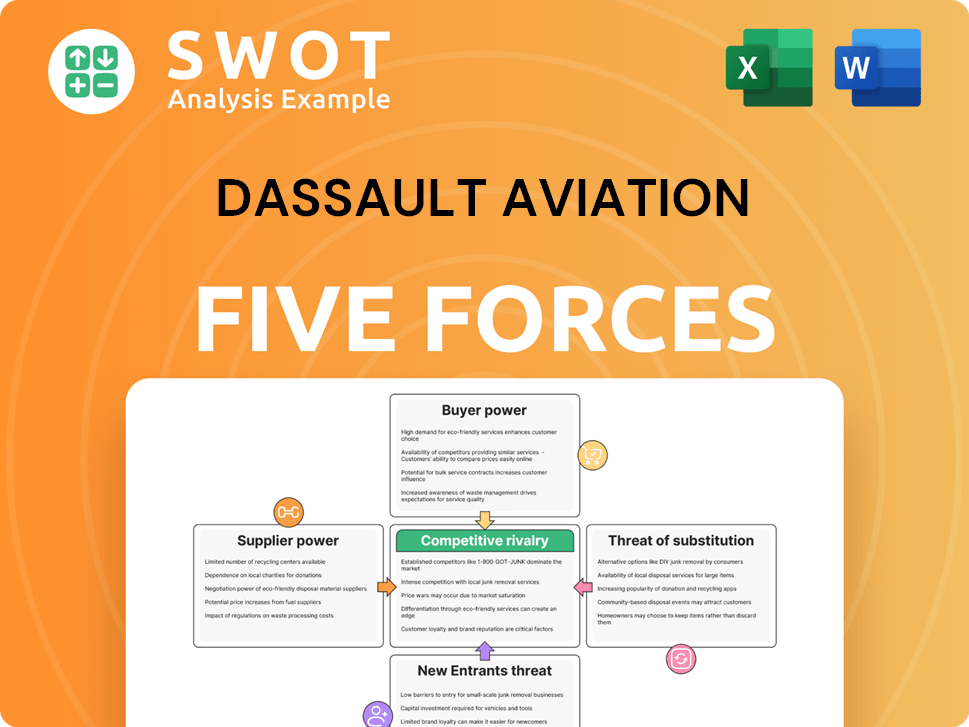
Related Blogs
- What are Mission Vision & Core Values of Dassault Aviation Company?
- What is Competitive Landscape of Dassault Aviation Company?
- What is Growth Strategy and Future Prospects of Dassault Aviation Company?
- How Does Dassault Aviation Company Work?
- What is Sales and Marketing Strategy of Dassault Aviation Company?
- What is Brief History of Dassault Aviation Company?
- What is Customer Demographics and Target Market of Dassault Aviation Company?
Disclaimer
All information, articles, and product details provided on this website are for general informational and educational purposes only. We do not claim any ownership over, nor do we intend to infringe upon, any trademarks, copyrights, logos, brand names, or other intellectual property mentioned or depicted on this site. Such intellectual property remains the property of its respective owners, and any references here are made solely for identification or informational purposes, without implying any affiliation, endorsement, or partnership.
We make no representations or warranties, express or implied, regarding the accuracy, completeness, or suitability of any content or products presented. Nothing on this website should be construed as legal, tax, investment, financial, medical, or other professional advice. In addition, no part of this site—including articles or product references—constitutes a solicitation, recommendation, endorsement, advertisement, or offer to buy or sell any securities, franchises, or other financial instruments, particularly in jurisdictions where such activity would be unlawful.
All content is of a general nature and may not address the specific circumstances of any individual or entity. It is not a substitute for professional advice or services. Any actions you take based on the information provided here are strictly at your own risk. You accept full responsibility for any decisions or outcomes arising from your use of this website and agree to release us from any liability in connection with your use of, or reliance upon, the content or products found herein.